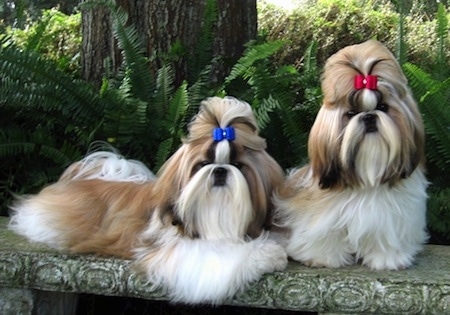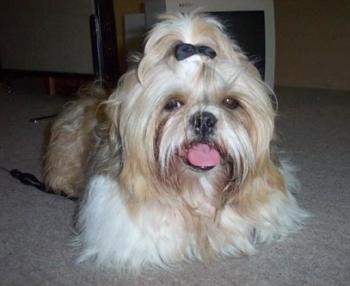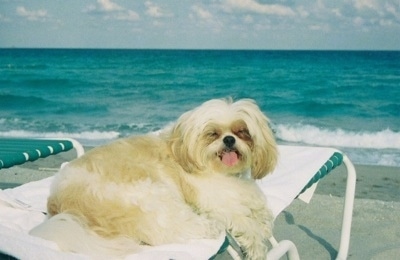The Norfolk Terrier is a strong, sturdy, short little dog. The head is slightly rounded, wide with a good amount of space between the ears. The wedge shaped muzzle is strong, with a well-defined stop. The small, oval shaped eyes are dark in color. The ears are small, hanging tight to the cheeks.
The legs are straight and the feet are round with black toe nails. The medium sized tail is set high level with the topline and is usually docked by half. Note: it is illegal to dock t`ils in most of Europe. The wiry, straight coat is about one and a half to two inches long. Coat colors include red, wheaten, tan, black and tan, or grizzle with or without dark points and occasionally with white markings.
Height: 10 inches (25cm.)
Weight: 10-12 pounds (4½-5½kg.)
These are the smallest of the Terriers.
Life Expectancy: About 12-15 years
Temperament
The Norfolk Terrier is among the smallest of the working terriers. Active, courageous, affectionate, balanced and without any nervousness or quarrelsomeness. They are easy to train, and need consistent rules to follow. These little dogs love everyone and are good with children. Because of their ratting instincts they tend to love anything you can toss so they can chase after it, such as toys, balls, sticks or bones.
If left outside for along period of time with nothing to do, without providing a long pack walk to drain their energy, they can become barkers and diggers. This breed is generally good with other pets such as cats and dogs, but should not be trusted with small animals such as hamster, pet rats, mice or guinea pigs.
Do not allow this little dog to develop small dog syndrome, where the dog believes he is pack leader to humans. This can cause many varying degrees of behavior problems including, but not limited to, separation anxiety, jealousy and guarding behaviour. They can be difficult to housebreak.
Living Conditions: Norfolks will do okay in an apartment if it is sufficiently exercised. They are fairly active indoors and will do okay without a yard.
Health Problems
- Hip dysplasia - Hind end limping, hind/back leg acts lame, can't move, weak legs. Wear and time causes the femur to fit poorly into the pelvic socket with improper rotation causing the Plott great pain, weakness and difficulty walking. You may notice the dog “hopping”” like a rabbit when running plus hesitating to climb stairs, all due to pain in the hind quarters. The problem actually starts as a very young puppy with an abnormal formation of the hip joint and grows progressively. A vet can locate this with a diagnostics test.
- Atopic dermatitis's—Atopy. Hereditary. Shows at 1 to 3 years age. Skin allergy triggered by dust mites, pollen, poor quality foods and other garbage we put into the dog’s environment. Many breeds are prone to this. The dog will lick, rub, chew and scratch the infected areas. Allergens can also come from fleas, bacteria and yeast infections. See your vet. There are many treatments ranging from medicines, antihistamines, diets, bathing, cleansing the house of dust mites and so on.
- Patellar luxation—Limping, Hind Leg Held Up, Can’t straighten back leg, weak legs. Caused by an unusually shallow spot on the femur, weak ligaments and misalignment of tendons and muscles that align the knee joint and allow the knee cap (patella) to float sideways in and out of position. This can be caused by injury or be present at birth and can affect both rear legs. It’s most common in small dogs like the English Cocker Spaniel. If your dog has trouble straightening the leg, is limping, lame or is walking on three legs and holding one hind leg up, look for patellar luxation. Several of my dogs have had the problem and all I’ve done is reach down, massage the knee a little until they drop their leg, and we’re good to go for another 3 or 4 months. Severe cases require surgery for a fully lame leg.
- Heart murmurs—Caused by congenital heart problems of acquired heart disease. A murmur can suggest an abnormal; heart valve, muscle disease, and abnormal opening, heartworms, a thyroid problem, or even anemia. Symptoms: Breathing problems, slow or fast heart rate, loss of appetite, total collapse, weakness, couching. There are many causes of murmur. Treatment depends on the cause and type of source.
- Progressive Retinal Atrophy—(PRA) An inherited, untreatable disease of the retina affecting both eyes causing blindness. It’s in thd genes of the dog and is not painful. Starts with night blindness and progresses as the retina gradually deteriorates.
- Cataracts—Hazy or cloudy vision which if not treated can cause total blindness.
- Glaucoma—A painful pressure in the eye which if not treated early on, will lead to total blindness.
Group: Terrier, AKC Terrier
Recognition: CKC, FCI, AKC, UKC, KCGB, CKC, ANKC, NKC, NZKC, CET, APRI, ACR, DRA, NAPR
Intelligence: The Norfolk Terrier will learn quickly what is expected of it, but the training*must be consistent as this terrier has a will of its own. As puppies they could try the patience of a saint at times, as they are so lively and playful.
Grooming
| Although the hard adult coat doesn’t appear until the puppy becomes an adolescent, grooming should be started at an early age; as this terrier can object to being restrained due to its independent streak. The coat is relatively easy to keep in good condition and will need to be hand plucked twice a year. A professional groomer or the breeder will be able to give advice on this. The shaggy, medium-length, waterproof coat is relatively easy, but daily combing and brushing is important. Little clipping is required. Take extra care when the dog is shedding. Bathe and dry shampoo only when necessary. This breed is a light shedder. |
Developed in East Anglia, England, the Norfolk and Norwich Terrier used to be the same breed with two different ear types, both were referred to as the Norwich Terrier. The English were the first to separate them in 1964. In 1979 the AKC officially deemed them as separate breeds.
The Norwich having small perked ears and the Norfolk with dropped ears. Another slight difference is, the Norfolks are angular in shape and the Norwich Terriers are more round. The dogs were used as barnyard ratters and to bolt foxes that had gone to ground during a fox hunt.
Their small size allowed them to get in and out of fox dens easily. After the foxes were flushed from their dens hunters on horseback would resume the chase with their hounds.
Colour: They came in variety of colour, more commonly seen in self colours such as all shades of red, wheaten, tan, grizzle or black, some may have limited white.
Coat Length: Short/Medium
Exercise
These little dogs were bred to work. They are energetic and thrive on an active life, and need to be taken on a daily walk. They can jog for short distance.
While out on the walk the dog must be made to heel beside or behind the person holding the lead, as in a dog's mind the leader leads the way, and that leader needs to be the human. Teach them to enter and exit all door and gateways after the human.
The Norfolk Terrier puppy can be stubborn and hard to house train, potty train, toilet train, housebreak or whatever you want to call it. If you have a puppy, decide if you want to crate or paper potty train it. For the best results, we have a page at Crate vs Paper Potty Training which will help you decide and from there you can get all the information you need to get the job done.
Always praise the pup profusely when she goes potty in the RIGHT PLACE so she knows she has done a good thing. Either method will work for this breed.If you have an older dog, take the dog outside every two hours until she gets the idea which door leads to her potty area. Older dogs catch on to the potty or housebreaking pretty fast once they are shown what to do.
HTML Comment Box is loading comments...

























